Economics for Business: Monopoly Market Structure and Price Setting
VerifiedAdded on 2020/02/24
|11
|2698
|883
Essay
AI Summary
This essay delves into the concept of monopoly market structure within the context of economics for business. It begins by defining a monopoly and identifying its key characteristics, such as lack of substitutes, barriers to entry, and control over price. The essay then explores the concept of natural monopolies and explains why they occur, using examples like the oil market. It examines the advantages and disadvantages of such market structures, including the analysis of revenue curves for a monopoly firm. The core of the essay focuses on the reasons why governments regulate the price setting of natural monopolies, including preventing excess prices, protecting service quality, and promoting competition. The essay provides a case study on the State Electricity Commission of New South Wales (Elcom) and how government regulation can impact the market. The essay concludes by highlighting the importance of government intervention to maintain market equilibrium and protect consumer interests, discussing policies such as price capping and regulatory commissions.
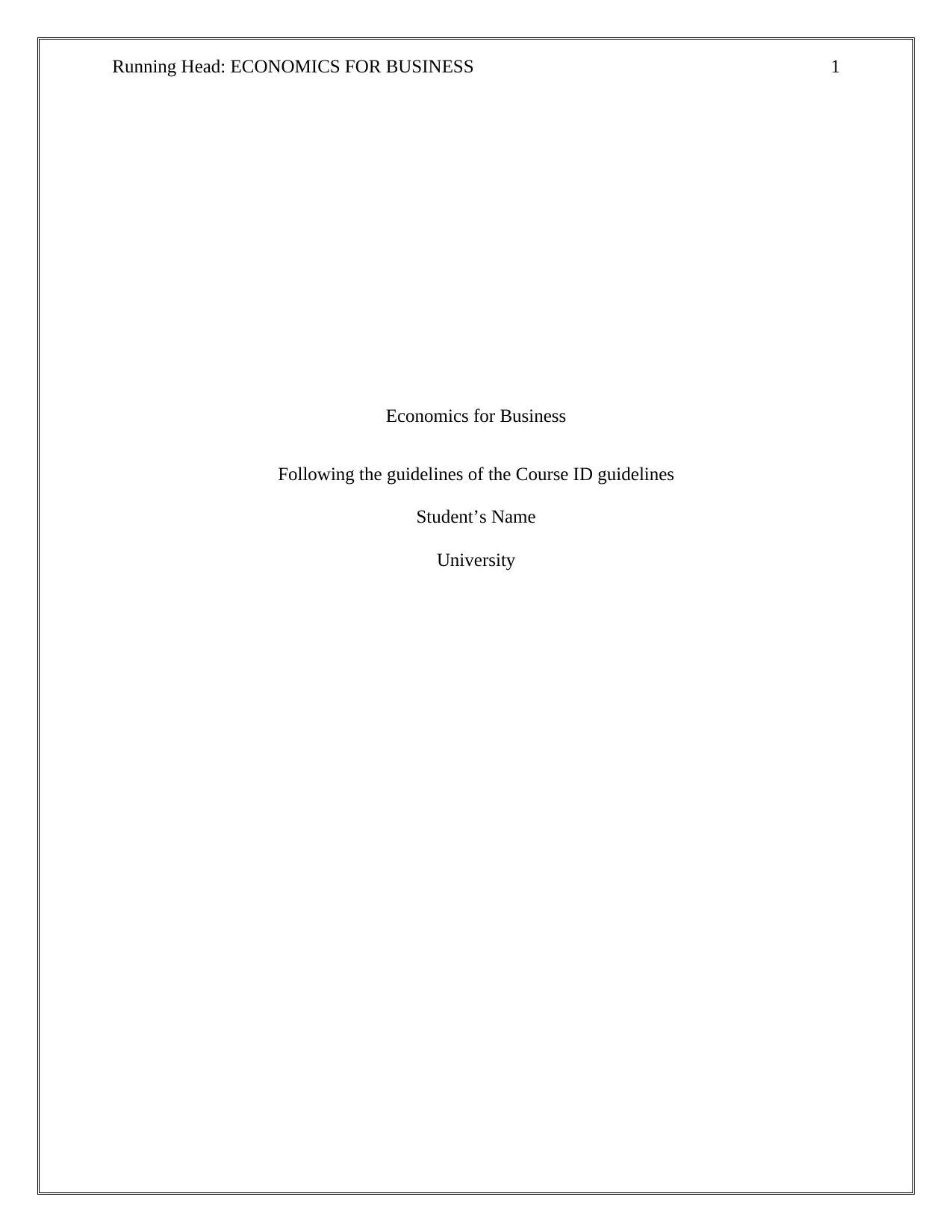
Running Head: ECONOMICS FOR BUSINESS 1
Economics for Business
Following the guidelines of the Course ID guidelines
Student’s Name
University
Economics for Business
Following the guidelines of the Course ID guidelines
Student’s Name
University
Paraphrase This Document
Need a fresh take? Get an instant paraphrase of this document with our AI Paraphraser
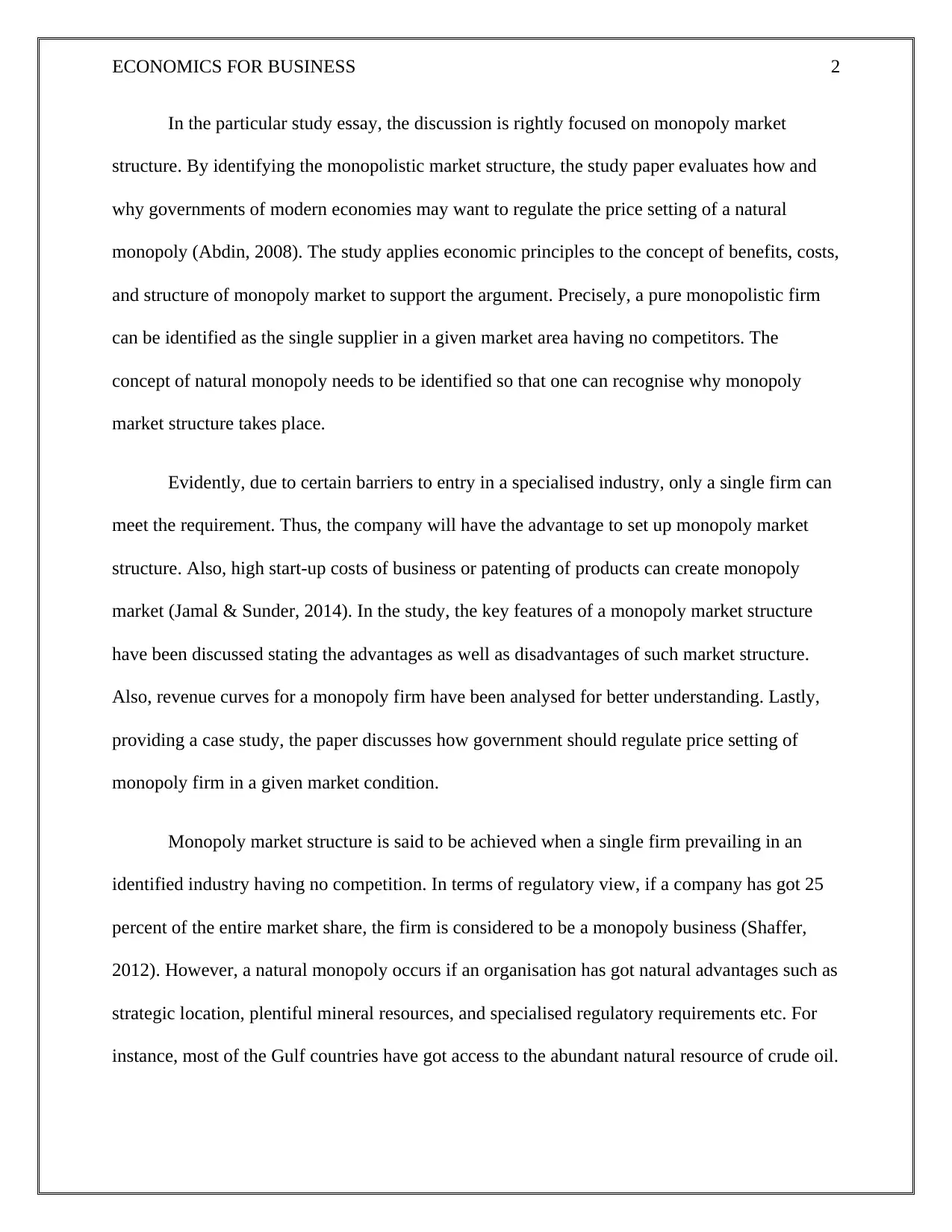
ECONOMICS FOR BUSINESS 2
In the particular study essay, the discussion is rightly focused on monopoly market
structure. By identifying the monopolistic market structure, the study paper evaluates how and
why governments of modern economies may want to regulate the price setting of a natural
monopoly (Abdin, 2008). The study applies economic principles to the concept of benefits, costs,
and structure of monopoly market to support the argument. Precisely, a pure monopolistic firm
can be identified as the single supplier in a given market area having no competitors. The
concept of natural monopoly needs to be identified so that one can recognise why monopoly
market structure takes place.
Evidently, due to certain barriers to entry in a specialised industry, only a single firm can
meet the requirement. Thus, the company will have the advantage to set up monopoly market
structure. Also, high start-up costs of business or patenting of products can create monopoly
market (Jamal & Sunder, 2014). In the study, the key features of a monopoly market structure
have been discussed stating the advantages as well as disadvantages of such market structure.
Also, revenue curves for a monopoly firm have been analysed for better understanding. Lastly,
providing a case study, the paper discusses how government should regulate price setting of
monopoly firm in a given market condition.
Monopoly market structure is said to be achieved when a single firm prevailing in an
identified industry having no competition. In terms of regulatory view, if a company has got 25
percent of the entire market share, the firm is considered to be a monopoly business (Shaffer,
2012). However, a natural monopoly occurs if an organisation has got natural advantages such as
strategic location, plentiful mineral resources, and specialised regulatory requirements etc. For
instance, most of the Gulf countries have got access to the abundant natural resource of crude oil.
In the particular study essay, the discussion is rightly focused on monopoly market
structure. By identifying the monopolistic market structure, the study paper evaluates how and
why governments of modern economies may want to regulate the price setting of a natural
monopoly (Abdin, 2008). The study applies economic principles to the concept of benefits, costs,
and structure of monopoly market to support the argument. Precisely, a pure monopolistic firm
can be identified as the single supplier in a given market area having no competitors. The
concept of natural monopoly needs to be identified so that one can recognise why monopoly
market structure takes place.
Evidently, due to certain barriers to entry in a specialised industry, only a single firm can
meet the requirement. Thus, the company will have the advantage to set up monopoly market
structure. Also, high start-up costs of business or patenting of products can create monopoly
market (Jamal & Sunder, 2014). In the study, the key features of a monopoly market structure
have been discussed stating the advantages as well as disadvantages of such market structure.
Also, revenue curves for a monopoly firm have been analysed for better understanding. Lastly,
providing a case study, the paper discusses how government should regulate price setting of
monopoly firm in a given market condition.
Monopoly market structure is said to be achieved when a single firm prevailing in an
identified industry having no competition. In terms of regulatory view, if a company has got 25
percent of the entire market share, the firm is considered to be a monopoly business (Shaffer,
2012). However, a natural monopoly occurs if an organisation has got natural advantages such as
strategic location, plentiful mineral resources, and specialised regulatory requirements etc. For
instance, most of the Gulf countries have got access to the abundant natural resource of crude oil.
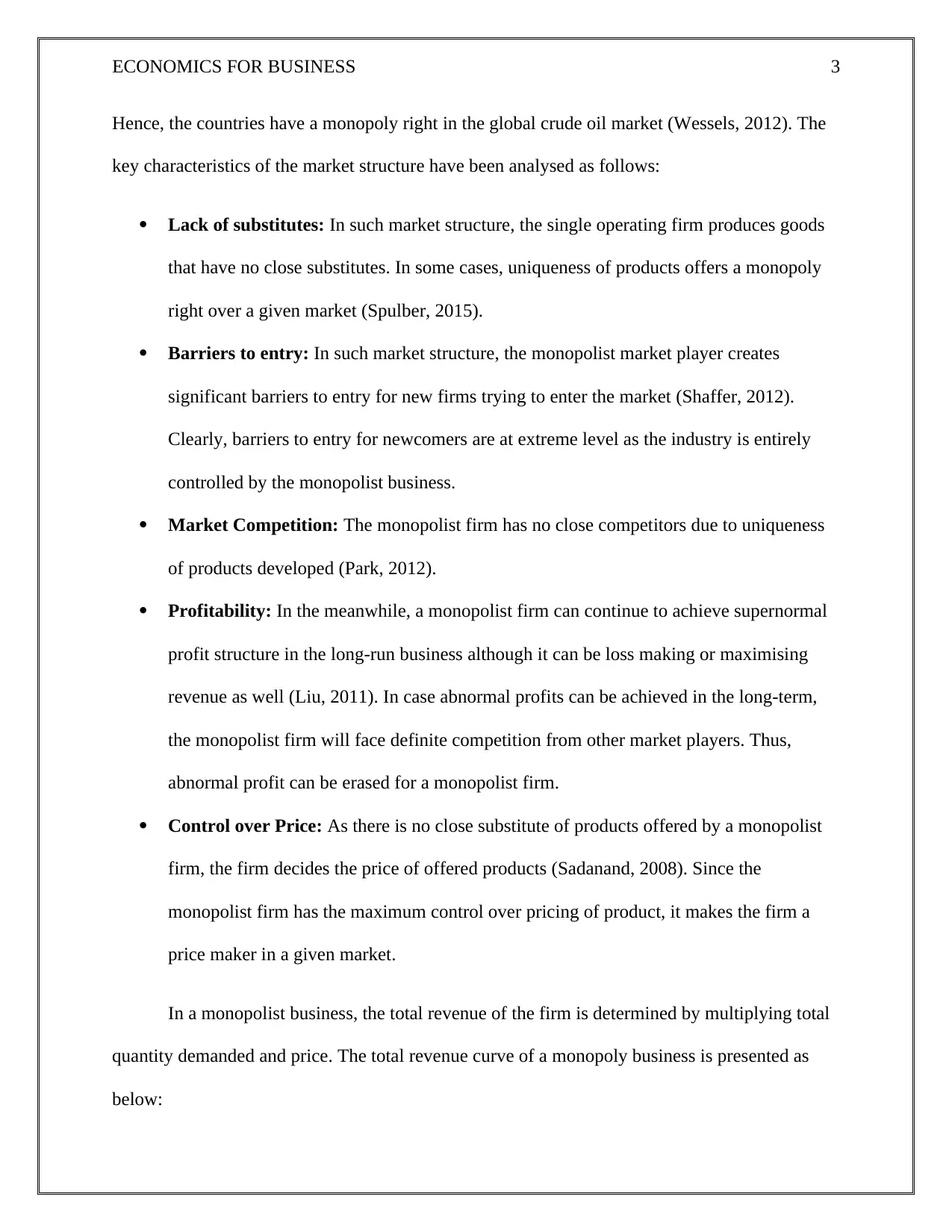
ECONOMICS FOR BUSINESS 3
Hence, the countries have a monopoly right in the global crude oil market (Wessels, 2012). The
key characteristics of the market structure have been analysed as follows:
Lack of substitutes: In such market structure, the single operating firm produces goods
that have no close substitutes. In some cases, uniqueness of products offers a monopoly
right over a given market (Spulber, 2015).
Barriers to entry: In such market structure, the monopolist market player creates
significant barriers to entry for new firms trying to enter the market (Shaffer, 2012).
Clearly, barriers to entry for newcomers are at extreme level as the industry is entirely
controlled by the monopolist business.
Market Competition: The monopolist firm has no close competitors due to uniqueness
of products developed (Park, 2012).
Profitability: In the meanwhile, a monopolist firm can continue to achieve supernormal
profit structure in the long-run business although it can be loss making or maximising
revenue as well (Liu, 2011). In case abnormal profits can be achieved in the long-term,
the monopolist firm will face definite competition from other market players. Thus,
abnormal profit can be erased for a monopolist firm.
Control over Price: As there is no close substitute of products offered by a monopolist
firm, the firm decides the price of offered products (Sadanand, 2008). Since the
monopolist firm has the maximum control over pricing of product, it makes the firm a
price maker in a given market.
In a monopolist business, the total revenue of the firm is determined by multiplying total
quantity demanded and price. The total revenue curve of a monopoly business is presented as
below:
Hence, the countries have a monopoly right in the global crude oil market (Wessels, 2012). The
key characteristics of the market structure have been analysed as follows:
Lack of substitutes: In such market structure, the single operating firm produces goods
that have no close substitutes. In some cases, uniqueness of products offers a monopoly
right over a given market (Spulber, 2015).
Barriers to entry: In such market structure, the monopolist market player creates
significant barriers to entry for new firms trying to enter the market (Shaffer, 2012).
Clearly, barriers to entry for newcomers are at extreme level as the industry is entirely
controlled by the monopolist business.
Market Competition: The monopolist firm has no close competitors due to uniqueness
of products developed (Park, 2012).
Profitability: In the meanwhile, a monopolist firm can continue to achieve supernormal
profit structure in the long-run business although it can be loss making or maximising
revenue as well (Liu, 2011). In case abnormal profits can be achieved in the long-term,
the monopolist firm will face definite competition from other market players. Thus,
abnormal profit can be erased for a monopolist firm.
Control over Price: As there is no close substitute of products offered by a monopolist
firm, the firm decides the price of offered products (Sadanand, 2008). Since the
monopolist firm has the maximum control over pricing of product, it makes the firm a
price maker in a given market.
In a monopolist business, the total revenue of the firm is determined by multiplying total
quantity demanded and price. The total revenue curve of a monopoly business is presented as
below:
⊘ This is a preview!⊘
Do you want full access?
Subscribe today to unlock all pages.

Trusted by 1+ million students worldwide
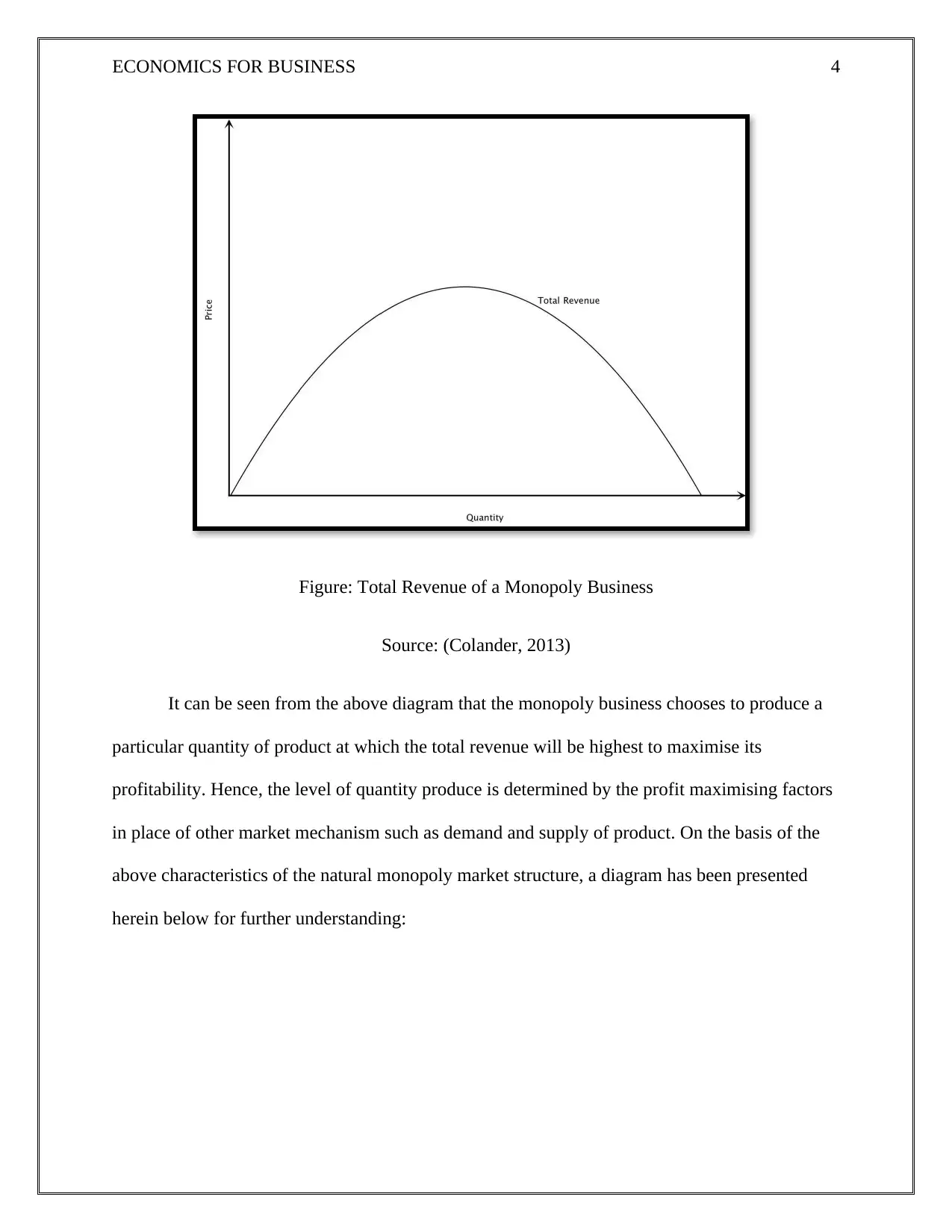
ECONOMICS FOR BUSINESS 4
Figure: Total Revenue of a Monopoly Business
Source: (Colander, 2013)
It can be seen from the above diagram that the monopoly business chooses to produce a
particular quantity of product at which the total revenue will be highest to maximise its
profitability. Hence, the level of quantity produce is determined by the profit maximising factors
in place of other market mechanism such as demand and supply of product. On the basis of the
above characteristics of the natural monopoly market structure, a diagram has been presented
herein below for further understanding:
Figure: Total Revenue of a Monopoly Business
Source: (Colander, 2013)
It can be seen from the above diagram that the monopoly business chooses to produce a
particular quantity of product at which the total revenue will be highest to maximise its
profitability. Hence, the level of quantity produce is determined by the profit maximising factors
in place of other market mechanism such as demand and supply of product. On the basis of the
above characteristics of the natural monopoly market structure, a diagram has been presented
herein below for further understanding:
Paraphrase This Document
Need a fresh take? Get an instant paraphrase of this document with our AI Paraphraser
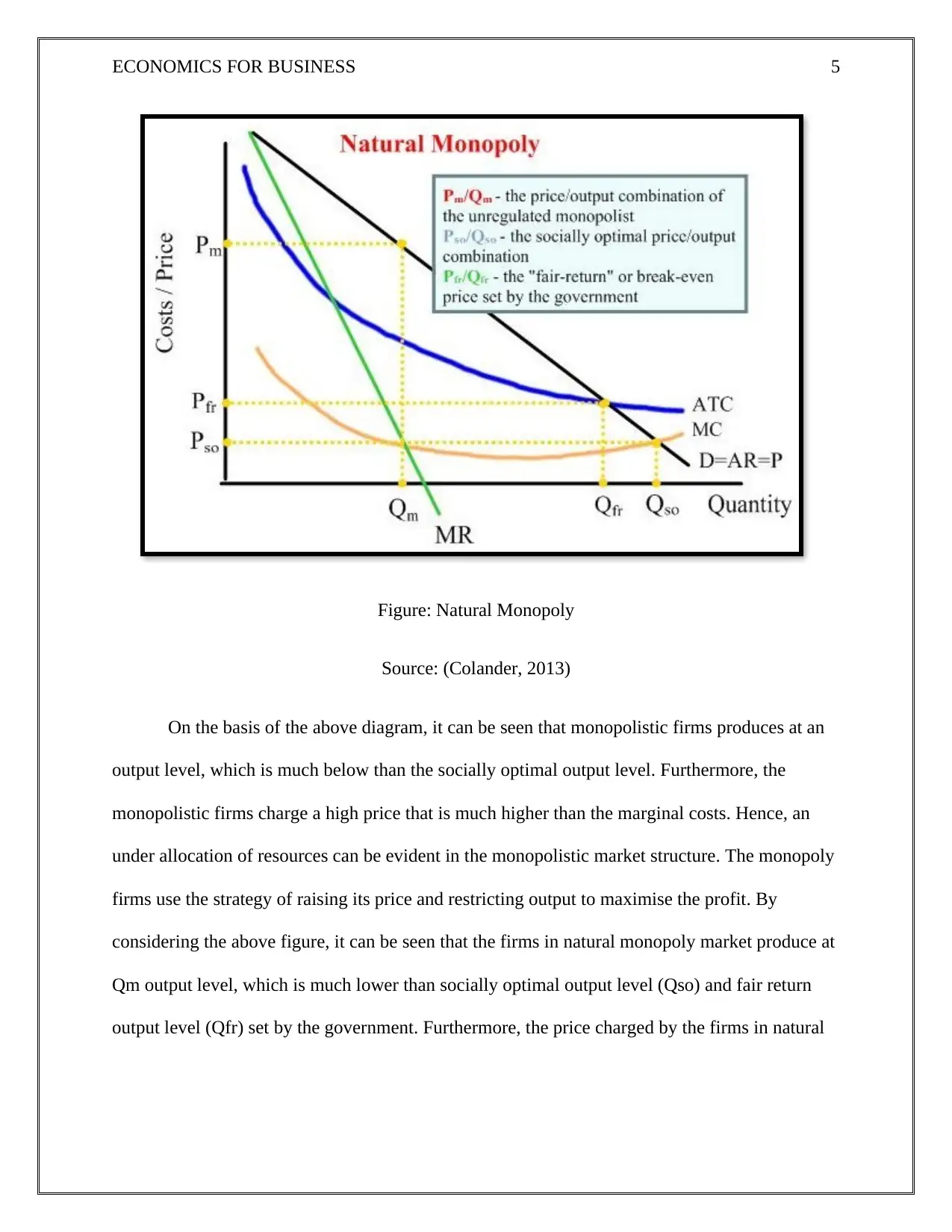
ECONOMICS FOR BUSINESS 5
Figure: Natural Monopoly
Source: (Colander, 2013)
On the basis of the above diagram, it can be seen that monopolistic firms produces at an
output level, which is much below than the socially optimal output level. Furthermore, the
monopolistic firms charge a high price that is much higher than the marginal costs. Hence, an
under allocation of resources can be evident in the monopolistic market structure. The monopoly
firms use the strategy of raising its price and restricting output to maximise the profit. By
considering the above figure, it can be seen that the firms in natural monopoly market produce at
Qm output level, which is much lower than socially optimal output level (Qso) and fair return
output level (Qfr) set by the government. Furthermore, the price charged by the firms in natural
Figure: Natural Monopoly
Source: (Colander, 2013)
On the basis of the above diagram, it can be seen that monopolistic firms produces at an
output level, which is much below than the socially optimal output level. Furthermore, the
monopolistic firms charge a high price that is much higher than the marginal costs. Hence, an
under allocation of resources can be evident in the monopolistic market structure. The monopoly
firms use the strategy of raising its price and restricting output to maximise the profit. By
considering the above figure, it can be seen that the firms in natural monopoly market produce at
Qm output level, which is much lower than socially optimal output level (Qso) and fair return
output level (Qfr) set by the government. Furthermore, the price charged by the firms in natural
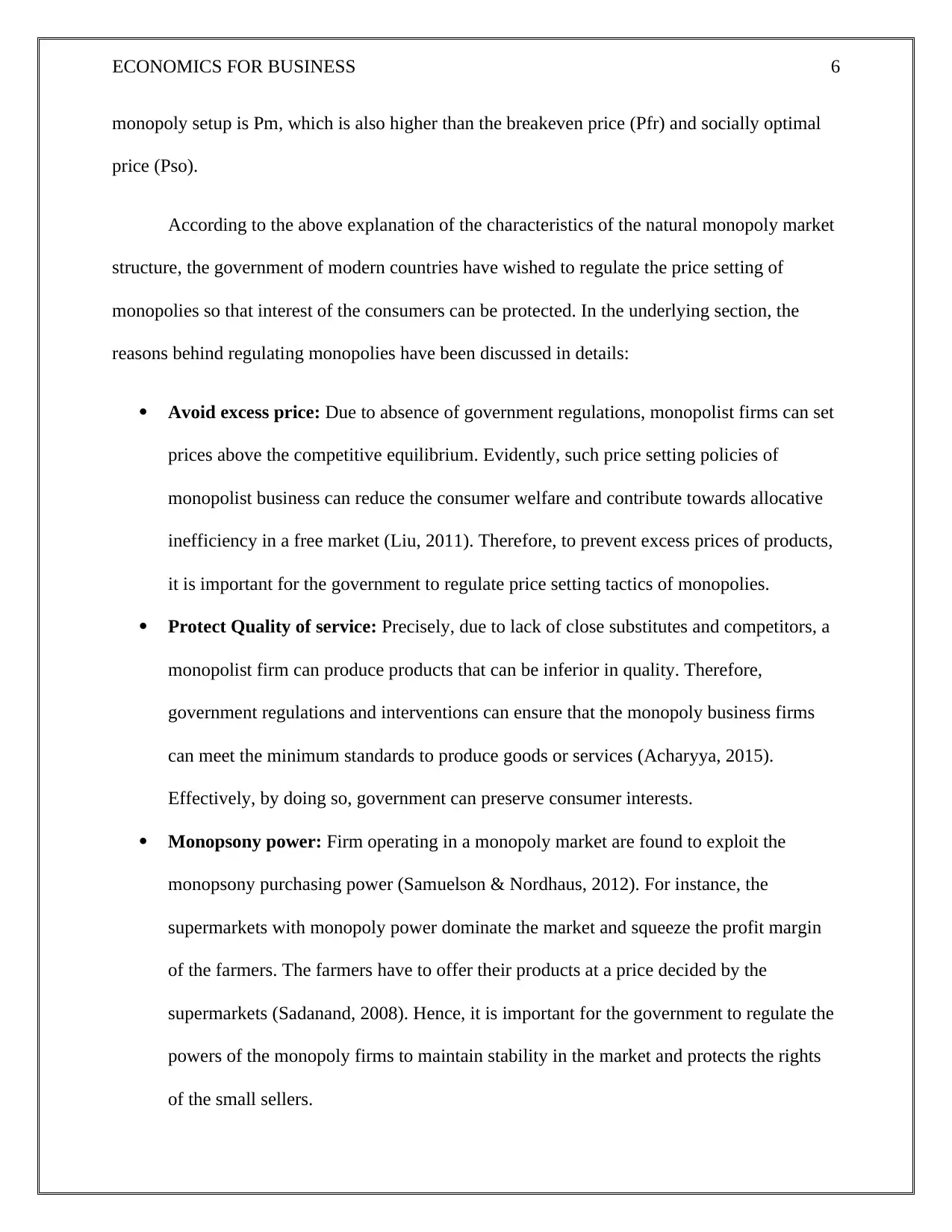
ECONOMICS FOR BUSINESS 6
monopoly setup is Pm, which is also higher than the breakeven price (Pfr) and socially optimal
price (Pso).
According to the above explanation of the characteristics of the natural monopoly market
structure, the government of modern countries have wished to regulate the price setting of
monopolies so that interest of the consumers can be protected. In the underlying section, the
reasons behind regulating monopolies have been discussed in details:
Avoid excess price: Due to absence of government regulations, monopolist firms can set
prices above the competitive equilibrium. Evidently, such price setting policies of
monopolist business can reduce the consumer welfare and contribute towards allocative
inefficiency in a free market (Liu, 2011). Therefore, to prevent excess prices of products,
it is important for the government to regulate price setting tactics of monopolies.
Protect Quality of service: Precisely, due to lack of close substitutes and competitors, a
monopolist firm can produce products that can be inferior in quality. Therefore,
government regulations and interventions can ensure that the monopoly business firms
can meet the minimum standards to produce goods or services (Acharyya, 2015).
Effectively, by doing so, government can preserve consumer interests.
Monopsony power: Firm operating in a monopoly market are found to exploit the
monopsony purchasing power (Samuelson & Nordhaus, 2012). For instance, the
supermarkets with monopoly power dominate the market and squeeze the profit margin
of the farmers. The farmers have to offer their products at a price decided by the
supermarkets (Sadanand, 2008). Hence, it is important for the government to regulate the
powers of the monopoly firms to maintain stability in the market and protects the rights
of the small sellers.
monopoly setup is Pm, which is also higher than the breakeven price (Pfr) and socially optimal
price (Pso).
According to the above explanation of the characteristics of the natural monopoly market
structure, the government of modern countries have wished to regulate the price setting of
monopolies so that interest of the consumers can be protected. In the underlying section, the
reasons behind regulating monopolies have been discussed in details:
Avoid excess price: Due to absence of government regulations, monopolist firms can set
prices above the competitive equilibrium. Evidently, such price setting policies of
monopolist business can reduce the consumer welfare and contribute towards allocative
inefficiency in a free market (Liu, 2011). Therefore, to prevent excess prices of products,
it is important for the government to regulate price setting tactics of monopolies.
Protect Quality of service: Precisely, due to lack of close substitutes and competitors, a
monopolist firm can produce products that can be inferior in quality. Therefore,
government regulations and interventions can ensure that the monopoly business firms
can meet the minimum standards to produce goods or services (Acharyya, 2015).
Effectively, by doing so, government can preserve consumer interests.
Monopsony power: Firm operating in a monopoly market are found to exploit the
monopsony purchasing power (Samuelson & Nordhaus, 2012). For instance, the
supermarkets with monopoly power dominate the market and squeeze the profit margin
of the farmers. The farmers have to offer their products at a price decided by the
supermarkets (Sadanand, 2008). Hence, it is important for the government to regulate the
powers of the monopoly firms to maintain stability in the market and protects the rights
of the small sellers.
⊘ This is a preview!⊘
Do you want full access?
Subscribe today to unlock all pages.

Trusted by 1+ million students worldwide
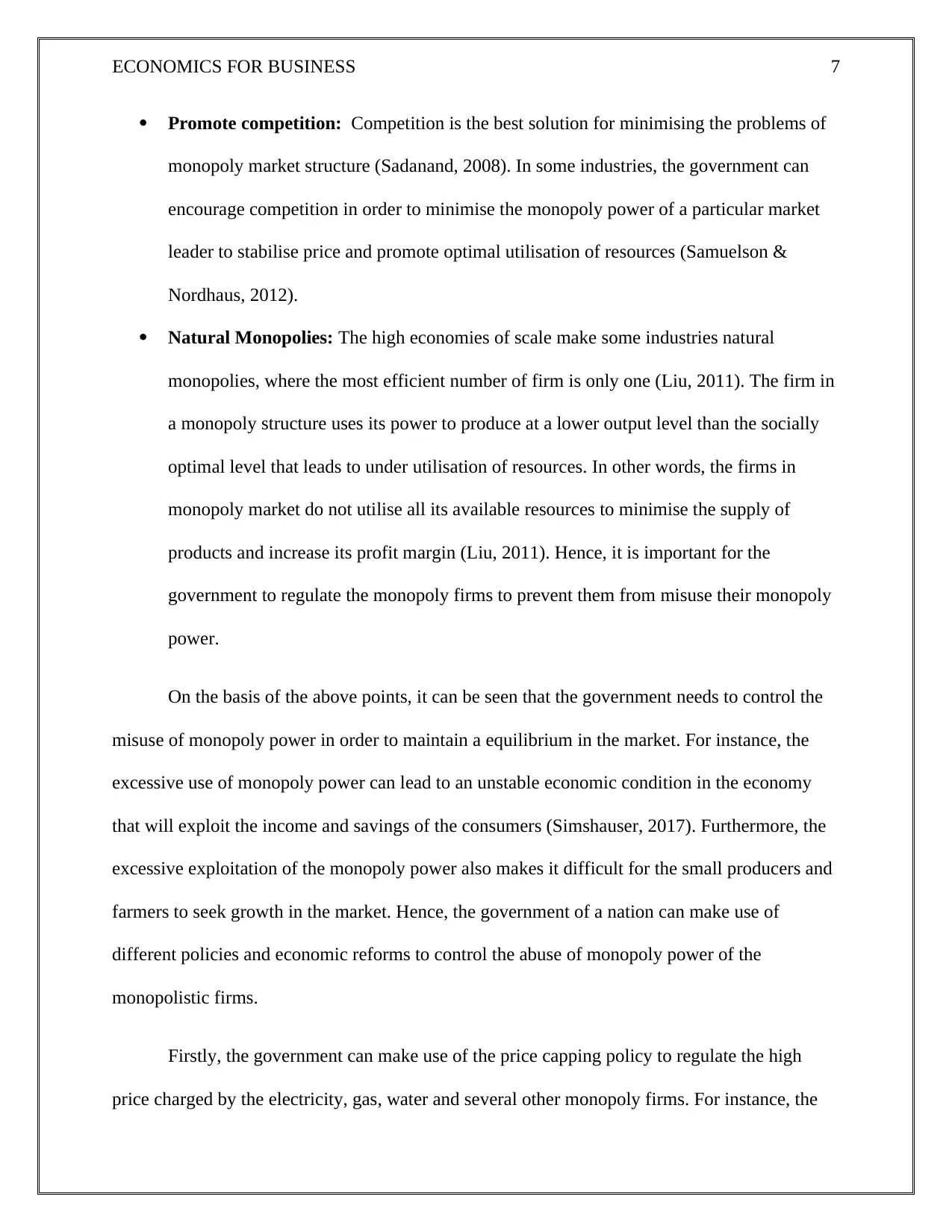
ECONOMICS FOR BUSINESS 7
Promote competition: Competition is the best solution for minimising the problems of
monopoly market structure (Sadanand, 2008). In some industries, the government can
encourage competition in order to minimise the monopoly power of a particular market
leader to stabilise price and promote optimal utilisation of resources (Samuelson &
Nordhaus, 2012).
Natural Monopolies: The high economies of scale make some industries natural
monopolies, where the most efficient number of firm is only one (Liu, 2011). The firm in
a monopoly structure uses its power to produce at a lower output level than the socially
optimal level that leads to under utilisation of resources. In other words, the firms in
monopoly market do not utilise all its available resources to minimise the supply of
products and increase its profit margin (Liu, 2011). Hence, it is important for the
government to regulate the monopoly firms to prevent them from misuse their monopoly
power.
On the basis of the above points, it can be seen that the government needs to control the
misuse of monopoly power in order to maintain a equilibrium in the market. For instance, the
excessive use of monopoly power can lead to an unstable economic condition in the economy
that will exploit the income and savings of the consumers (Simshauser, 2017). Furthermore, the
excessive exploitation of the monopoly power also makes it difficult for the small producers and
farmers to seek growth in the market. Hence, the government of a nation can make use of
different policies and economic reforms to control the abuse of monopoly power of the
monopolistic firms.
Firstly, the government can make use of the price capping policy to regulate the high
price charged by the electricity, gas, water and several other monopoly firms. For instance, the
Promote competition: Competition is the best solution for minimising the problems of
monopoly market structure (Sadanand, 2008). In some industries, the government can
encourage competition in order to minimise the monopoly power of a particular market
leader to stabilise price and promote optimal utilisation of resources (Samuelson &
Nordhaus, 2012).
Natural Monopolies: The high economies of scale make some industries natural
monopolies, where the most efficient number of firm is only one (Liu, 2011). The firm in
a monopoly structure uses its power to produce at a lower output level than the socially
optimal level that leads to under utilisation of resources. In other words, the firms in
monopoly market do not utilise all its available resources to minimise the supply of
products and increase its profit margin (Liu, 2011). Hence, it is important for the
government to regulate the monopoly firms to prevent them from misuse their monopoly
power.
On the basis of the above points, it can be seen that the government needs to control the
misuse of monopoly power in order to maintain a equilibrium in the market. For instance, the
excessive use of monopoly power can lead to an unstable economic condition in the economy
that will exploit the income and savings of the consumers (Simshauser, 2017). Furthermore, the
excessive exploitation of the monopoly power also makes it difficult for the small producers and
farmers to seek growth in the market. Hence, the government of a nation can make use of
different policies and economic reforms to control the abuse of monopoly power of the
monopolistic firms.
Firstly, the government can make use of the price capping policy to regulate the high
price charged by the electricity, gas, water and several other monopoly firms. For instance, the
Paraphrase This Document
Need a fresh take? Get an instant paraphrase of this document with our AI Paraphraser
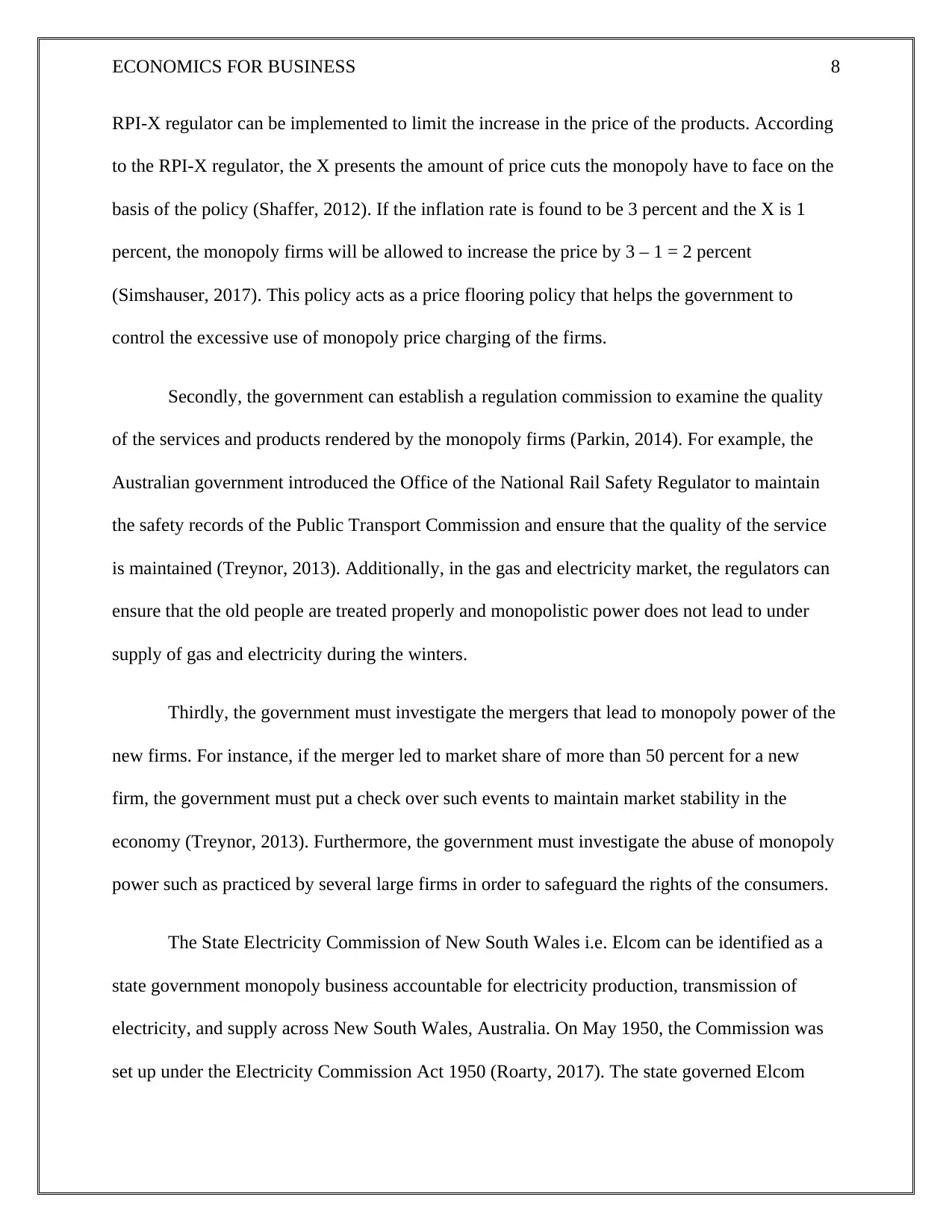
ECONOMICS FOR BUSINESS 8
RPI-X regulator can be implemented to limit the increase in the price of the products. According
to the RPI-X regulator, the X presents the amount of price cuts the monopoly have to face on the
basis of the policy (Shaffer, 2012). If the inflation rate is found to be 3 percent and the X is 1
percent, the monopoly firms will be allowed to increase the price by 3 – 1 = 2 percent
(Simshauser, 2017). This policy acts as a price flooring policy that helps the government to
control the excessive use of monopoly price charging of the firms.
Secondly, the government can establish a regulation commission to examine the quality
of the services and products rendered by the monopoly firms (Parkin, 2014). For example, the
Australian government introduced the Office of the National Rail Safety Regulator to maintain
the safety records of the Public Transport Commission and ensure that the quality of the service
is maintained (Treynor, 2013). Additionally, in the gas and electricity market, the regulators can
ensure that the old people are treated properly and monopolistic power does not lead to under
supply of gas and electricity during the winters.
Thirdly, the government must investigate the mergers that lead to monopoly power of the
new firms. For instance, if the merger led to market share of more than 50 percent for a new
firm, the government must put a check over such events to maintain market stability in the
economy (Treynor, 2013). Furthermore, the government must investigate the abuse of monopoly
power such as practiced by several large firms in order to safeguard the rights of the consumers.
The State Electricity Commission of New South Wales i.e. Elcom can be identified as a
state government monopoly business accountable for electricity production, transmission of
electricity, and supply across New South Wales, Australia. On May 1950, the Commission was
set up under the Electricity Commission Act 1950 (Roarty, 2017). The state governed Elcom
RPI-X regulator can be implemented to limit the increase in the price of the products. According
to the RPI-X regulator, the X presents the amount of price cuts the monopoly have to face on the
basis of the policy (Shaffer, 2012). If the inflation rate is found to be 3 percent and the X is 1
percent, the monopoly firms will be allowed to increase the price by 3 – 1 = 2 percent
(Simshauser, 2017). This policy acts as a price flooring policy that helps the government to
control the excessive use of monopoly price charging of the firms.
Secondly, the government can establish a regulation commission to examine the quality
of the services and products rendered by the monopoly firms (Parkin, 2014). For example, the
Australian government introduced the Office of the National Rail Safety Regulator to maintain
the safety records of the Public Transport Commission and ensure that the quality of the service
is maintained (Treynor, 2013). Additionally, in the gas and electricity market, the regulators can
ensure that the old people are treated properly and monopolistic power does not lead to under
supply of gas and electricity during the winters.
Thirdly, the government must investigate the mergers that lead to monopoly power of the
new firms. For instance, if the merger led to market share of more than 50 percent for a new
firm, the government must put a check over such events to maintain market stability in the
economy (Treynor, 2013). Furthermore, the government must investigate the abuse of monopoly
power such as practiced by several large firms in order to safeguard the rights of the consumers.
The State Electricity Commission of New South Wales i.e. Elcom can be identified as a
state government monopoly business accountable for electricity production, transmission of
electricity, and supply across New South Wales, Australia. On May 1950, the Commission was
set up under the Electricity Commission Act 1950 (Roarty, 2017). The state governed Elcom
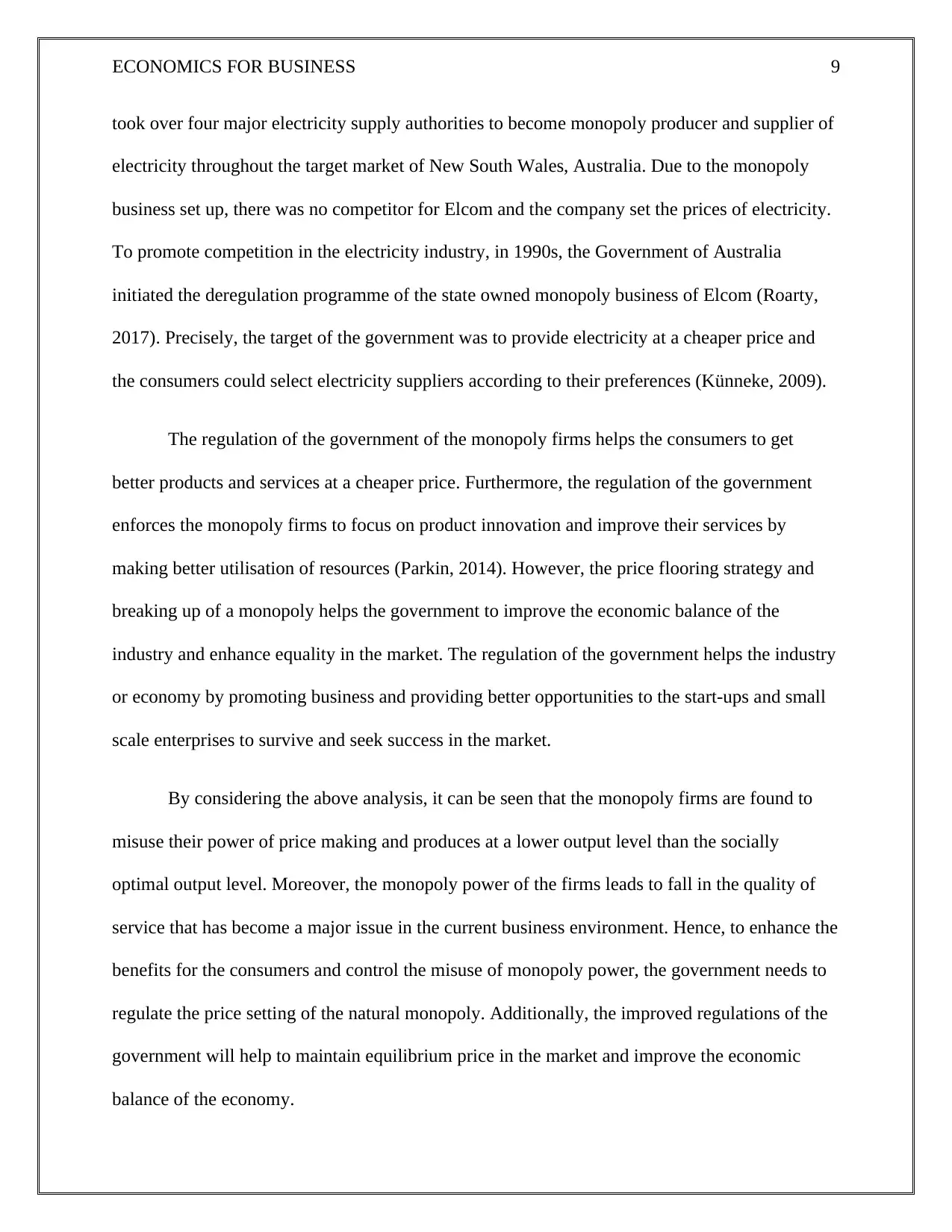
ECONOMICS FOR BUSINESS 9
took over four major electricity supply authorities to become monopoly producer and supplier of
electricity throughout the target market of New South Wales, Australia. Due to the monopoly
business set up, there was no competitor for Elcom and the company set the prices of electricity.
To promote competition in the electricity industry, in 1990s, the Government of Australia
initiated the deregulation programme of the state owned monopoly business of Elcom (Roarty,
2017). Precisely, the target of the government was to provide electricity at a cheaper price and
the consumers could select electricity suppliers according to their preferences (Künneke, 2009).
The regulation of the government of the monopoly firms helps the consumers to get
better products and services at a cheaper price. Furthermore, the regulation of the government
enforces the monopoly firms to focus on product innovation and improve their services by
making better utilisation of resources (Parkin, 2014). However, the price flooring strategy and
breaking up of a monopoly helps the government to improve the economic balance of the
industry and enhance equality in the market. The regulation of the government helps the industry
or economy by promoting business and providing better opportunities to the start-ups and small
scale enterprises to survive and seek success in the market.
By considering the above analysis, it can be seen that the monopoly firms are found to
misuse their power of price making and produces at a lower output level than the socially
optimal output level. Moreover, the monopoly power of the firms leads to fall in the quality of
service that has become a major issue in the current business environment. Hence, to enhance the
benefits for the consumers and control the misuse of monopoly power, the government needs to
regulate the price setting of the natural monopoly. Additionally, the improved regulations of the
government will help to maintain equilibrium price in the market and improve the economic
balance of the economy.
took over four major electricity supply authorities to become monopoly producer and supplier of
electricity throughout the target market of New South Wales, Australia. Due to the monopoly
business set up, there was no competitor for Elcom and the company set the prices of electricity.
To promote competition in the electricity industry, in 1990s, the Government of Australia
initiated the deregulation programme of the state owned monopoly business of Elcom (Roarty,
2017). Precisely, the target of the government was to provide electricity at a cheaper price and
the consumers could select electricity suppliers according to their preferences (Künneke, 2009).
The regulation of the government of the monopoly firms helps the consumers to get
better products and services at a cheaper price. Furthermore, the regulation of the government
enforces the monopoly firms to focus on product innovation and improve their services by
making better utilisation of resources (Parkin, 2014). However, the price flooring strategy and
breaking up of a monopoly helps the government to improve the economic balance of the
industry and enhance equality in the market. The regulation of the government helps the industry
or economy by promoting business and providing better opportunities to the start-ups and small
scale enterprises to survive and seek success in the market.
By considering the above analysis, it can be seen that the monopoly firms are found to
misuse their power of price making and produces at a lower output level than the socially
optimal output level. Moreover, the monopoly power of the firms leads to fall in the quality of
service that has become a major issue in the current business environment. Hence, to enhance the
benefits for the consumers and control the misuse of monopoly power, the government needs to
regulate the price setting of the natural monopoly. Additionally, the improved regulations of the
government will help to maintain equilibrium price in the market and improve the economic
balance of the economy.
⊘ This is a preview!⊘
Do you want full access?
Subscribe today to unlock all pages.

Trusted by 1+ million students worldwide
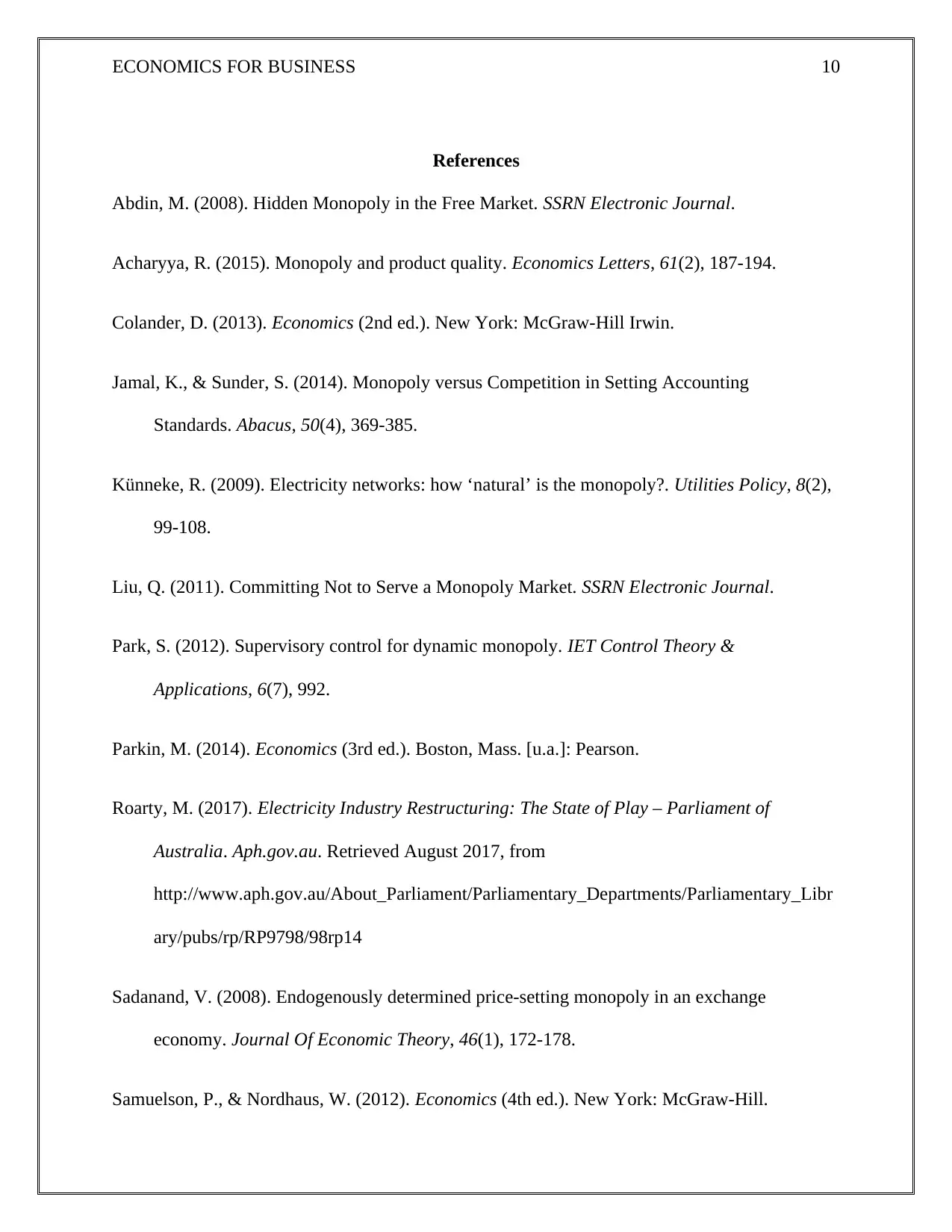
ECONOMICS FOR BUSINESS 10
References
Abdin, M. (2008). Hidden Monopoly in the Free Market. SSRN Electronic Journal.
Acharyya, R. (2015). Monopoly and product quality. Economics Letters, 61(2), 187-194.
Colander, D. (2013). Economics (2nd ed.). New York: McGraw-Hill Irwin.
Jamal, K., & Sunder, S. (2014). Monopoly versus Competition in Setting Accounting
Standards. Abacus, 50(4), 369-385.
Künneke, R. (2009). Electricity networks: how ‘natural’ is the monopoly?. Utilities Policy, 8(2),
99-108.
Liu, Q. (2011). Committing Not to Serve a Monopoly Market. SSRN Electronic Journal.
Park, S. (2012). Supervisory control for dynamic monopoly. IET Control Theory &
Applications, 6(7), 992.
Parkin, M. (2014). Economics (3rd ed.). Boston, Mass. [u.a.]: Pearson.
Roarty, M. (2017). Electricity Industry Restructuring: The State of Play – Parliament of
Australia. Aph.gov.au. Retrieved August 2017, from
http://www.aph.gov.au/About_Parliament/Parliamentary_Departments/Parliamentary_Libr
ary/pubs/rp/RP9798/98rp14
Sadanand, V. (2008). Endogenously determined price-setting monopoly in an exchange
economy. Journal Of Economic Theory, 46(1), 172-178.
Samuelson, P., & Nordhaus, W. (2012). Economics (4th ed.). New York: McGraw-Hill.
References
Abdin, M. (2008). Hidden Monopoly in the Free Market. SSRN Electronic Journal.
Acharyya, R. (2015). Monopoly and product quality. Economics Letters, 61(2), 187-194.
Colander, D. (2013). Economics (2nd ed.). New York: McGraw-Hill Irwin.
Jamal, K., & Sunder, S. (2014). Monopoly versus Competition in Setting Accounting
Standards. Abacus, 50(4), 369-385.
Künneke, R. (2009). Electricity networks: how ‘natural’ is the monopoly?. Utilities Policy, 8(2),
99-108.
Liu, Q. (2011). Committing Not to Serve a Monopoly Market. SSRN Electronic Journal.
Park, S. (2012). Supervisory control for dynamic monopoly. IET Control Theory &
Applications, 6(7), 992.
Parkin, M. (2014). Economics (3rd ed.). Boston, Mass. [u.a.]: Pearson.
Roarty, M. (2017). Electricity Industry Restructuring: The State of Play – Parliament of
Australia. Aph.gov.au. Retrieved August 2017, from
http://www.aph.gov.au/About_Parliament/Parliamentary_Departments/Parliamentary_Libr
ary/pubs/rp/RP9798/98rp14
Sadanand, V. (2008). Endogenously determined price-setting monopoly in an exchange
economy. Journal Of Economic Theory, 46(1), 172-178.
Samuelson, P., & Nordhaus, W. (2012). Economics (4th ed.). New York: McGraw-Hill.
Paraphrase This Document
Need a fresh take? Get an instant paraphrase of this document with our AI Paraphraser
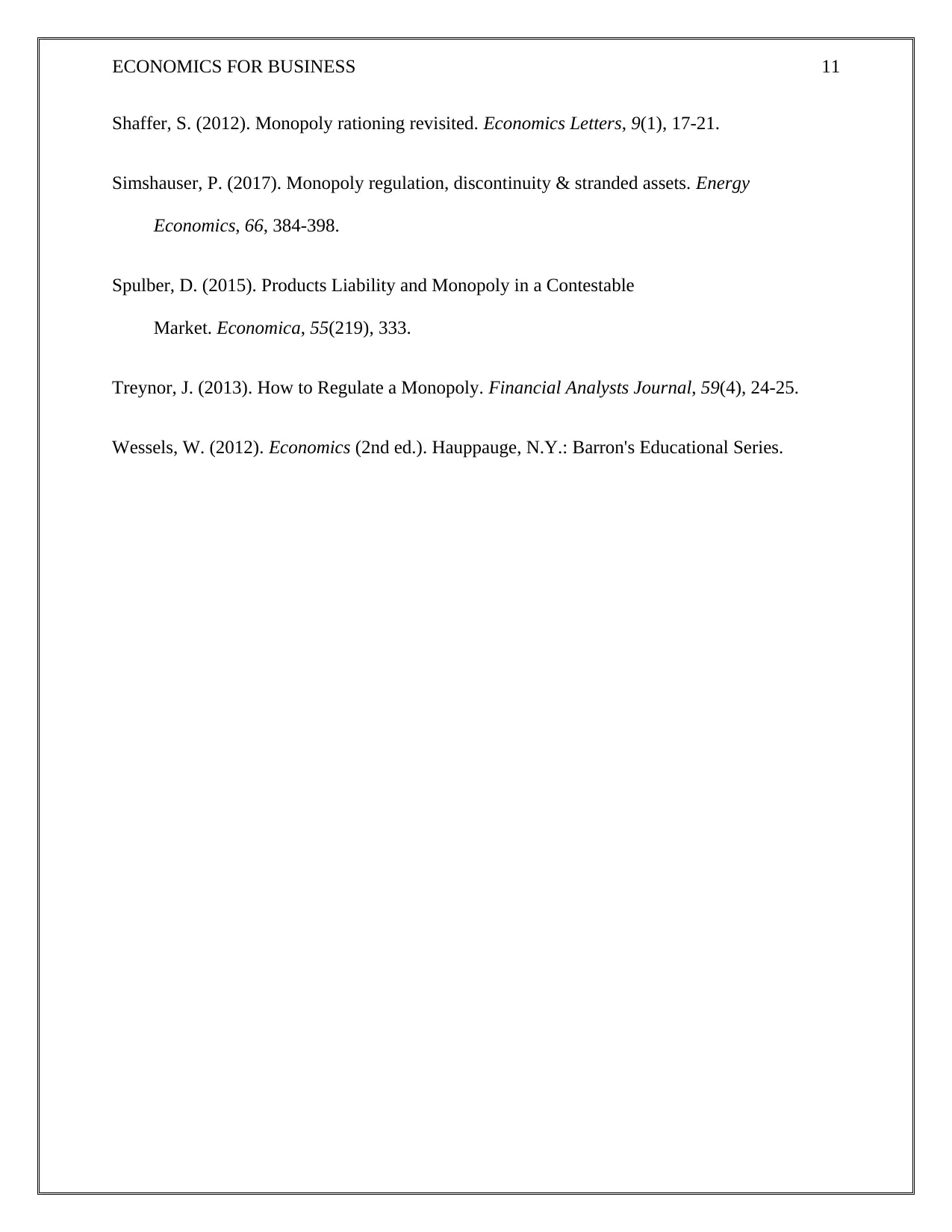
ECONOMICS FOR BUSINESS 11
Shaffer, S. (2012). Monopoly rationing revisited. Economics Letters, 9(1), 17-21.
Simshauser, P. (2017). Monopoly regulation, discontinuity & stranded assets. Energy
Economics, 66, 384-398.
Spulber, D. (2015). Products Liability and Monopoly in a Contestable
Market. Economica, 55(219), 333.
Treynor, J. (2013). How to Regulate a Monopoly. Financial Analysts Journal, 59(4), 24-25.
Wessels, W. (2012). Economics (2nd ed.). Hauppauge, N.Y.: Barron's Educational Series.
Shaffer, S. (2012). Monopoly rationing revisited. Economics Letters, 9(1), 17-21.
Simshauser, P. (2017). Monopoly regulation, discontinuity & stranded assets. Energy
Economics, 66, 384-398.
Spulber, D. (2015). Products Liability and Monopoly in a Contestable
Market. Economica, 55(219), 333.
Treynor, J. (2013). How to Regulate a Monopoly. Financial Analysts Journal, 59(4), 24-25.
Wessels, W. (2012). Economics (2nd ed.). Hauppauge, N.Y.: Barron's Educational Series.
1 out of 11
Related Documents
Your All-in-One AI-Powered Toolkit for Academic Success.
+13062052269
info@desklib.com
Available 24*7 on WhatsApp / Email
![[object Object]](/_next/static/media/star-bottom.7253800d.svg)
Unlock your academic potential
Copyright © 2020–2025 A2Z Services. All Rights Reserved. Developed and managed by ZUCOL.





